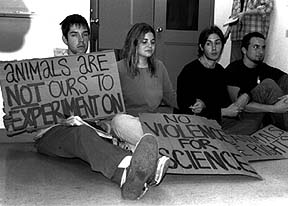








Eighteen students and members of Oberlin Animal Rights (OAR) disrupted a laboratory class Thursday in Sperry Neuroscience Building to protest the use of animals in scientific research at Oberlin. Four of the protestors entered the Intro. to Neuroscience Lab class where a lab making use of rats was about to take place, while other participants stood in the hall outside the classroom bearing signs with slogans such as "NO BLOOD FOR SCIENCE" and "BOYCOTT VIVISECTION - FREE THE RATS."
A statement of protest which called for the discontinuation of animal use and experimentation in Intro. Neuroscience labs for the remainder of this school year was read by sophomore Aaron Simmons, chair of OAR. The statement said, "We ... hold that advances in science must not come through the harming or violation of any other living being."
The group claimed that attempts to bring about discussion with members of the administration have been unsuccessful in the  past and that, in the words of sophomore protestor Kim Defeo, protest "is the only avenue we have left."
past and that, in the words of sophomore protestor Kim Defeo, protest "is the only avenue we have left."
When asked to leave by Denison Smith, professor of psychology and neuroscience, the protestors inside the lab linked arms and sat down. "If we left just allowing discussion in the future, we're allowing these rats to just lose their lives," Simmons said.
Defeo added, "I'm not willing to compromise away the life of a rat."
Security, along with Director of Residential Life Deborah McNish and Yeworkwha Belachew, assistant dean of students, were called in to assess the situation. In the meantime, Smith and members of his class decided not to proceed with the day's scheduled experiment due to the protest.
After the students left, eight of the protestors, along with McNish, Smith, Smith's laboratory technician, Gigi Knight and Barbara Fuchsman, a member of the animal care and use committee, stayed to discuss the two sides' fundamental differences in belief concerning animal experimentation in science and to explore possible alternatives to such use.
Among the alternatives suggested by OAR were computer models of the procedures that would otherwise be conducted on animals. In response to this suggestion, Smith said that the neccessity for laboratory research on biological organisms lies in our inability to create computer systems complex enough that the results gained from their study would be as reliable as research on animals.
Smith said that a biological science constrained solely to the use of computer models "would be such an anemic science that it would be irrelevant and should not be offered at this school under such restrained conditions."
The protestors agreed to leave at 4 p.m., stating that further discussion through institutional channels would be undertaken.
Speaking after the demonstration, the OAR participants expressed satisfaction with the discussion that had taken place. Sophomore protestor Jonathan Edmonds said, "We have shown that we have a legitimate voice on campus, that we have legitimate concerns."
Speaking afterwards, Smith said, "We are more than willing to hold dialogue with these groups."
Blocking the Door: Members of Oberlin Animal Rights protested and succeeded in halting a neuroscience lab Thursday afternoon. (photo by Michelle Becker)

Copyright © 1996, The Oberlin Review.
Volume 124, Number 22; April 26, 1996
Contact Review webmaster with suggestions or comments at ocreview@www.oberlin.edu.
Contact Review editorial staff at oreview@oberlin.edu.